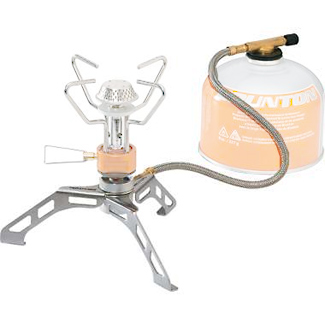nhluhr wrote:Probably because PR agents, marketing writers, and journalists don't have engineering degrees.squishy wrote:CClaude wrote:Actually cannister stoves work better at higher altitude
That statement contradicts everything I've read or been told about canister stoves...
The only thing that causes a problem for canister stoves is cold, since they generally rely on the vapor pressure of the liquid fuel to push gaseous fuel out of the nozzle. If the fuel gets too cold and won't vaporize, it doesn't feed gas to the nozzle. As you may be able to tell, the relative pressure pushing gas out of the cansiter will be the difference in internal pressure (which is a function of temperature and type/amount of gas remaining) and external temperature. If you drop the outside temp by ascending in altitude, the resulting difference in pressure is bigger. The confusion that most journalists and marketeers don't understand is that high altitude generally comes with an associated drop in temperature (which dramatically affects the internal pressure).
n-butane (like in your typical bic lighter or like what's mixed in a Primus fuel canister) boils at 32 deg F (0 deg C). This means if the canister hits below that temp, there is little or no n-butane gas boiling off the liquid in the canister to flow out the fuel line to the nozzle.
iso-butane (like in some high end lighters or what's mixed in Snow Peak ProIso, MSR IsoPro, Jetboil canisters, etc) boils around 12 deg F. This means canisters utilizing isobutane instead of n-butane work at lower temperatures.
Propane (like what's mixed in almost all common canisters to some concentration or what's present in those heavy steel green or white canisters for coleman stoves) boils around -40 deg F. This is what they use in northern michigan when they go ice fishing in the winter.
The colder you get, the lower the partial pressure for the fuels gets and the smaller the partial pressure relative to other components of the fuel, the less of that component gets boiled off and used in your stove. If you use a canister between the boiling points of the fuel components, you will eventually end up with a canister with no more propane to boil off and a bunch of liquid butane.
The Snow Peak ProIso canisters have a mixture of 65% isobutane and 35% propane. Other isobutane/propane mixture canisters are 70/30. This higher propane concentration means they will work longer/harder in colder temps.
Primus canisters are all but useless in cold weather situations becuase they use n-butane as their primary component.
There is a way to defeat the above problems to deal with ultra-cold conditions and that is to use a remote fuel canister with stoves such as the Jetboil Helios, Primus EtaPackLite, or similar stoves that have a pre-heat coil (fuel line goes through the flame) and the ability to invert the fuel canister. This means only liquid fuel is pushed out the nozzle of the canister, leaving gaseous propane (plus whatever amount of butane that boils off in your temperature application) to keep the canister pressurized.
Inverting the canister with something like a Brunton Stove Stand doesn't work well for stoves like the MSR Reactor or Primus EtaExpress because they don't have fuel pre-heat lines to vaporize the fuel before it gets to the regulator/nozzle. The reactor does still work better than some at low temperatures because its regulator seems to run at little lower pressure, so it's usable longer, but in use, the Reactor still loses power in cold unless you take measures to keep the canister warm.
Well, you used enough big words and numbers to convince me. I assume you've checked your facts?















